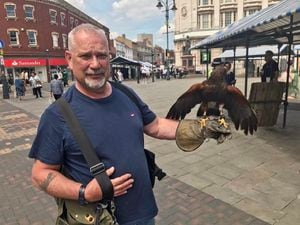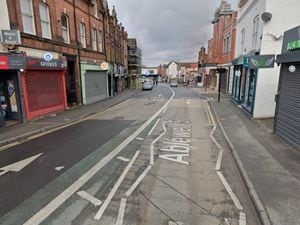How a hawk helps tackle ‘nuisance’ pigeons in Walsall town centre
“Harris Hawks are bone idle by nature. He knows I’ve got the food. He knows I’ll reward him just for chasing them.”

Whilst this might sound a bit like a parent nagging a lazy teenager, it’s actually welcome reassurance for pigeon fanciers alarmed by the presence of Taffy the Harris Hawk in Walsall town centre.
For almost three years now, workers, shoppers and visitors have been treated to the sight of the beautiful bird of prey carrying out his work.
Graham Lees, of Lichfield Falconry, was hired by Walsall Council to stop pigeons nesting on roofs which in turn resulted in a deluge of mess being left all over significant monuments such as the Cenotaph and the Source of Ingenuity fountain.
And the initiative is proving to be a success so far with pigeon numbers down to single figures compared with more than 100 which used to hang around in the town centre.
Mr Lees, who set up the business in 2007 and has a total of 21 birds of prey, said 15-year-old Taffy’s presence has resulted in pigeons being driven out of the town centre.
He said: “The Cenotaph was covered in pigeon mess. What we’re trying to do is get the pigeons to think he has moved in so they go find somewhere else.
“It’s a programme I’ve used over the years which has proved to work. We came everyday for two weeks and then twice weekly for four weeks.
“The pigeons suddenly saw him everyday and the science behind it is getting the pigeons more concerned when they can’t see him than when they can.
“It was not a case of flying him around all the time, you fly him around so they know he is there and then ‘hide’. They’ll then come down thinking he is gone and then you let the hawk off again.
“So the pigeons would fly off and then worry if they can’t see him and wonder ‘where is he?’
“It’s made a huge difference. When we started, the pigeons would hang around on roofs. There were around 140 pigeons and now there are 4-6. Some days you go down (by the Cenotaph) and you see none at all.”
Even after almost three years, Taffy gets a lot of attention on his visits – now down to once a week – to the town from people of all ages fascinated by him and wanting to take photographs.
But the method has raised concern amongst animal lovers and pigeon fanciers who are worried Taffy will catch and kill the birds.
Mr Lees said: “When I first came, people would say ‘oh that’s not right’ but when you talk to them and explain what you are doing and how it is done they are ok.
“You can let him off in circumstances where he has a good chance of catching them or you can let him off when he has no chance. So I tend to let him off when there is no chance.
“The other side to it is he knows I’ve got the food and they are lazy. He knows I’ll reward him just for chasing them so he will do that, come back and look at me as if to say, ‘come on then, where’s my reward?’.
“He knows he has to scare them and if he does that he gets a reward.”
He added: “There have been instances where he has had them but it’s the exception rather than the rule and the ones he’s caught are probably ones who had something wrong with them. Pigeons can easily out fly him.”
In the wild, the South American native would live 15-18 years but Mr Lees said in captivity they have no stress and know they’ll be fed, which increases their life expectancy. Taffy’s dad lived to the age of 26.
While Taffy and other hawks are used in town centres and football stadium to drive the pigeons away, Mr Lees said he uses different birds for different problems such as Peregrine Falcons for gulls and Chilean Blue Eagles for Canada Geese.
He also carries out school visits and attends shows which explains why Taffy is so comfortable amongst people and not a danger to the public.
Although a guttural scream from Taffy when he spotted a canine did highlight one problem.
Mr Lees said: “That was a warning shout. They have an in-built problem with dogs because in South America the only predator they’ve got is a coyote.
Councillor Kerry Murphy, Portfolio Holder for Clean and Green said: “Pigeons nest all year round in UK and they can cause a nuisance in our town.
“In these sort of situations the mobility of a bird of prey is a humane and effective way to deter pigeons roosting on our buildings, given the threat of a predator in the area.
“We first deployed this as a means of control in 2019, which has worked reasonably well along with providing an attraction in the town.
“Each visit with the hawk take a couple of hours at periodic intervals to avoid routine patterns of behaviour, and the approach is suitable to open spaces, buildings and tight enclosed spaces like multi storey and underground car parks, as well as areas that are hard to reach and therefore unsuitable for other bird proofing methods.”





